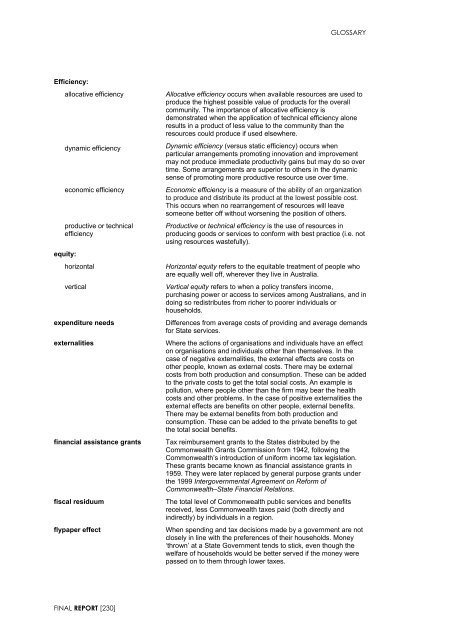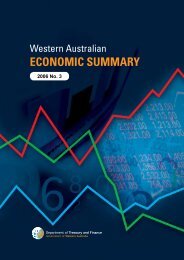Garnaut Fitzgerald Review of Commonwealth-State Funding
Garnaut Fitzgerald Review of Commonwealth-State Funding
Garnaut Fitzgerald Review of Commonwealth-State Funding
Create successful ePaper yourself
Turn your PDF publications into a flip-book with our unique Google optimized e-Paper software.
GLOSSARY<br />
Efficiency:<br />
allocative efficiency<br />
dynamic efficiency<br />
economic efficiency<br />
productive or technical<br />
efficiency<br />
equity:<br />
horizontal<br />
vertical<br />
expenditure needs<br />
externalities<br />
financial assistance grants<br />
fiscal residuum<br />
flypaper effect<br />
Allocative efficiency occurs when available resources are used to<br />
produce the highest possible value <strong>of</strong> products for the overall<br />
community. The importance <strong>of</strong> allocative efficiency is<br />
demonstrated when the application <strong>of</strong> technical efficiency alone<br />
results in a product <strong>of</strong> less value to the community than the<br />
resources could produce if used elsewhere.<br />
Dynamic efficiency (versus static efficiency) occurs when<br />
particular arrangements promoting innovation and improvement<br />
may not produce immediate productivity gains but may do so over<br />
time. Some arrangements are superior to others in the dynamic<br />
sense <strong>of</strong> promoting more productive resource use over time.<br />
Economic efficiency is a measure <strong>of</strong> the ability <strong>of</strong> an organization<br />
to produce and distribute its product at the lowest possible cost.<br />
This occurs when no rearrangement <strong>of</strong> resources will leave<br />
someone better <strong>of</strong>f without worsening the position <strong>of</strong> others.<br />
Productive or technical efficiency is the use <strong>of</strong> resources in<br />
producing goods or services to conform with best practice (i.e. not<br />
using resources wastefully).<br />
Horizontal equity refers to the equitable treatment <strong>of</strong> people who<br />
are equally well <strong>of</strong>f, wherever they live in Australia.<br />
Vertical equity refers to when a policy transfers income,<br />
purchasing power or access to services among Australians, and in<br />
doing so redistributes from richer to poorer individuals or<br />
households.<br />
Differences from average costs <strong>of</strong> providing and average demands<br />
for <strong>State</strong> services.<br />
Where the actions <strong>of</strong> organisations and individuals have an effect<br />
on organisations and individuals other than themselves. In the<br />
case <strong>of</strong> negative externalities, the external effects are costs on<br />
other people, known as external costs. There may be external<br />
costs from both production and consumption. These can be added<br />
to the private costs to get the total social costs. An example is<br />
pollution, where people other than the firm may bear the health<br />
costs and other problems. In the case <strong>of</strong> positive externalities the<br />
external effects are benefits on other people, external benefits.<br />
There may be external benefits from both production and<br />
consumption. These can be added to the private benefits to get<br />
the total social benefits.<br />
Tax reimbursement grants to the <strong>State</strong>s distributed by the<br />
<strong>Commonwealth</strong> Grants Commission from 1942, following the<br />
<strong>Commonwealth</strong>’s introduction <strong>of</strong> uniform income tax legislation.<br />
These grants became known as financial assistance grants in<br />
1959. They were later replaced by general purpose grants under<br />
the 1999 Intergovernmental Agreement on Reform <strong>of</strong><br />
<strong>Commonwealth</strong>–<strong>State</strong> Financial Relations.<br />
The total level <strong>of</strong> <strong>Commonwealth</strong> public services and benefits<br />
received, less <strong>Commonwealth</strong> taxes paid (both directly and<br />
indirectly) by individuals in a region.<br />
When spending and tax decisions made by a government are not<br />
closely in line with the preferences <strong>of</strong> their households. Money<br />
‘thrown’ at a <strong>State</strong> Government tends to stick, even though the<br />
welfare <strong>of</strong> households would be better served if the money were<br />
passed on to them through lower taxes.<br />
FINAL REPORT [230]

















